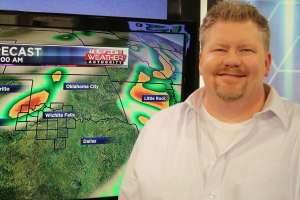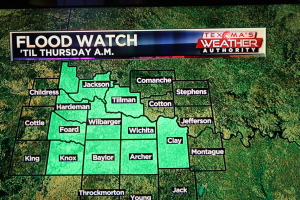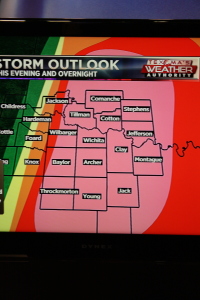
April 10, 1979 has been and will always be a day to remember in Wichita Falls history. Terrible Tuesday, the day a mile-wide tornado came sweeping through the town of Wichita Falls nearly wiping it off the map.
Spring is back and it’s that time of year again when Texas encounters heavy rainstorms, flooding, strong winds, tornadoes, hail and lightening.
There are simple safety guidelines and procedures that can be the difference between life and death this storm season.
Tornadoes are one of Mother Nature’s most violent annihilators and can strike with little to no warning.
Bryan Rupp, KFDX 3 meteorologist, said severe weather should not be treated lightly.
“Take severe weather seriously. The national weather service does not issue warnings lightly.”
Students can put an emergency kit together that will keep them prepared ahead of time, Rupp said.
“You want to get a kit together, flashlight, important papers, band aids, and a medical kit. Keep in your kit medication spares of all the medications you need to take on a regular basis. Have at least a one month supply of medication. That’s the best thing you can do.”
Rupp said people should be able to survive without government assistant for up to 72 hours.
“You may want to keep can goods on hand and a can opener so you’re prepared. You need to be able to sustain yourself without government assistance for up to 72 hours. After that, the National Guard usually comes and they give you ready to eat meals. The amount of food you need is really not all that much, but 72 hours’ worth.”
Add a camera to the weather survival kit. Taking a picture will help document weather damaged items for insurance purposes, Rupp said.
“Get a digital camera in there, so that when you have damage to your dwelling you can take pictures for insurance purposes for everything.That way you have a better chance of getting your money back.”
Rupp said he recommends students who live on campus to check with residence hall assistants to see what the weather safety protocols are.
“Well the first thing I recommend is check with the dorm, because the dorm will have a plan of where to go during a tornado event. If students have not done that, the best thing to possibly do is get to the lowest floor and enter a room with few windows, preferably with none. It’s highly recommended to use a helmet to protect your head during a tornado.”
The same rules apply to all students who live off campus as well, said Rupp.
“It’s the same situation. Figure out where to go for safety in the home during a tornado. The best thing is to get below ground in a bunker or a basement and once down there, stay away from windows at all cost. If there is not a bunker, or a basement, go to the first floor to a closet or bathroom that does not have windows.”
MSU police follow specific weather protocol to keep the students of MSU safe.
Patrick Coggins, police chief, said he doesn’t rely only on local news to stay informed, but also relies on emails from the Emergency Operations Center. He prefers to have multiple sources of information to stay as up-to-date as possible.
“We don’t only rely on local weather we also get our information from the Texas Law Enforcement Terminal System. It is a computer system that is used all over the state that will send out sever weather alerts. I also watch my email for information coming from the Wichita Falls Emergency Operations Center. Then we will issue alerts if the tornado will directly affect camps.”
If there are students on campus during the time of the alert, there are designated areas on campus deemed not safe and should be avoided because the buildings are not concrete reinforced. You want to put as much stuff between you and the tornado, Coggins said.
“Stay away from open areas like auditoriums. There are a list of places that are not good places to be. The music halls, band hall, McCullough Hall, Vision Health Center, and Sunwatcher. You can also look in the Residence Life Handbook that will give additional information.”
Coggins said if a tornado is headed to MSU, a loudspeaker system is set up in the heart of the campus that can broadcast warnings across campus.
“If the tornado is going to directly affect campus, then we will also do a loud speaker broadcast. We have a multi speaker system that is in place to reach the majority of people on campus. They are by the Daniel building, Prothro Yeager and the Clark Student Center, places that are in the heart of the university so that we can reach the students.”
FLOOD WARNINGS

When driving in the rain be careful of the surroundings. Watch out for large puddles or flooded roadways said Rupp.
“If you’re in a vehicle never drive through flooded roadways because you don’t know what happened when you weren’t there as far as the intensity of the rain coming down it could have washed away the roadway. If it washes away the road way, you have nothing to drive on and then that would increase the opportunity that your car could be washed away.”
KFDX reporter Rupp said people of all ages experience such situations.
“We see this happen all the time to adults, students, and teen drivers they all fall victim to this. The second thing you can do of course to stay well ahead of the storm is to stay tuned to KFDX TV 3 and listen for our flood watches that we put into effect and just be on your guard during that time period if you’re out walking again avoid any areas of water standing because you don’t know what has happened to that surface.”
COLOR CODING STORM OUTLOOK

RED | Indicated a moderate risk of severe weather including the almost certainty of severe thunderstorm and or tornado watches being issued with widespread warnings across the watch area. Multiple damaging wind events and tornado reports are likely to occur.
![]()
GREEN| indicate strong thunderstorms (including small hail, gusty winds, frequent lightning and thunder) are possible but severe weather is not likely.
![]()
LIGHT ORANGE| slight risk of severe weather including the likelihood of a watch and a handful of severe weather and/or tornado warnings
![]()
ORANGE| enhanced risk of severe weather including the likelihood of multiple watches, severe severe thunderstorm warnings and tornado warnings.![]()
PINK| high risk of severe weather including multiple watches and a widespread outbreak of severe weather and tornadoes resulting in dozens of warnings and some strong, long-lived, large tornadoes likely.
RELATED STORIES
Wichita Falls resembled a city ravaged by war.
Additonal Reporting: Hunter Porter
















